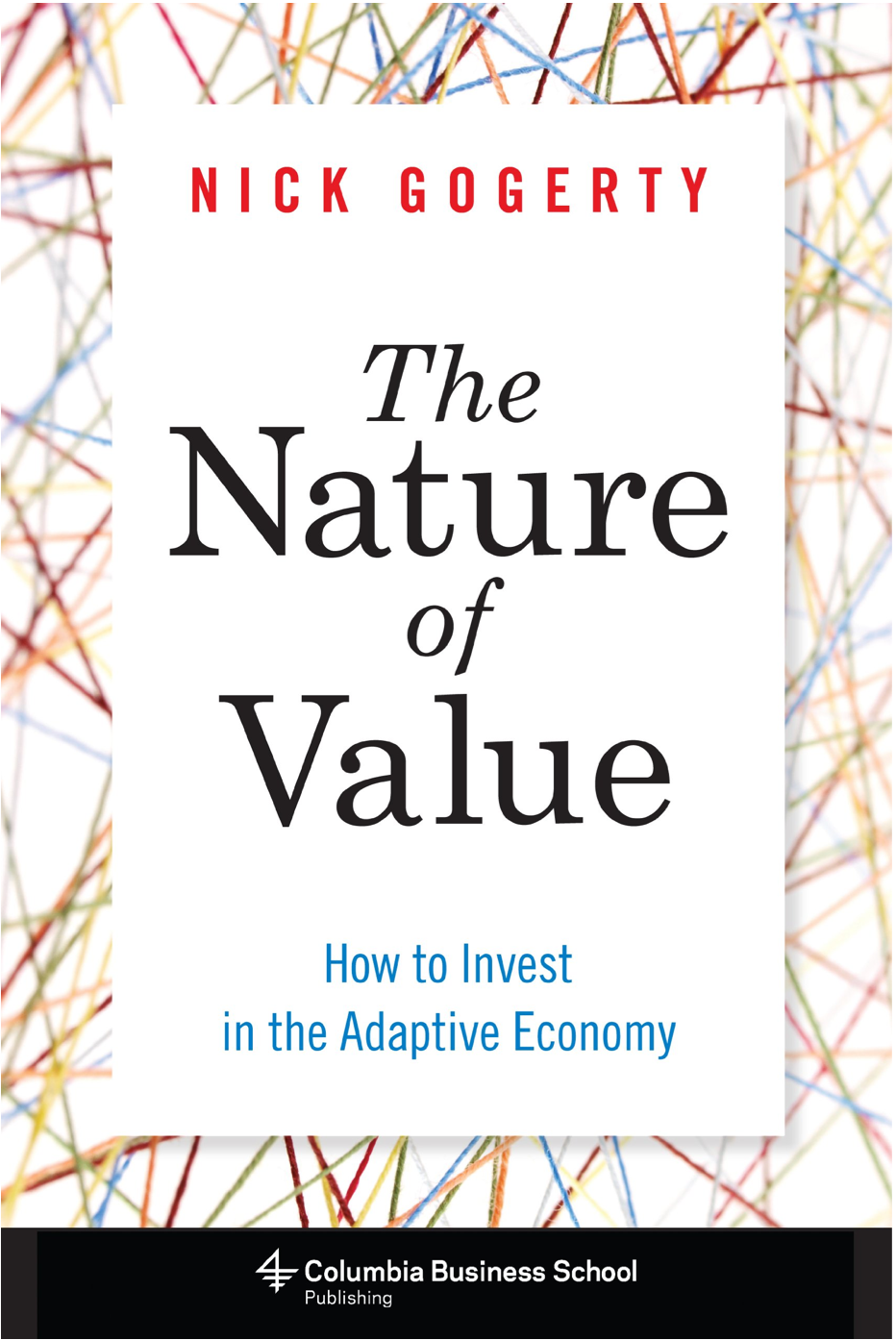by Tom Brakke, Research Puzzle
When I travel, I try to meet with people and organizations from different parts of the investment world — to learn their stories and to exchange ideas. Those meetings foster fruitful relationships and spark new areas of pursuit (intellectually and professionally).
One of the most engaging of those conversations was with Nick Gogerty in a university club (to which neither of us belonged) in New York City. I was amazed at the number of interesting concepts that we touched upon in a relatively short period of time. Many of them now appear in Gogerty’s new book, “The Nature of Value.”
There is so much in the book that this short review will hardly do it justice. The title and the subtitle (“How to Invest in the Adaptive Economy”) get at the overriding theme: the adaptations of value and of biological life proceed in similar fashions, with economic interactions being reflective of the workings of nature’s ecosystems. Great analogies between the two appear throughout the book, so that an ino is to a gene as an organization is to an organism, a cluster to a niche, and economy to ecology. (One fun — and apt — example compares rams to Ram trucks.)
(One fun — and apt — example compares rams to Ram trucks.)
“Ino” is shorthand for a unit of information associated with innovation “that has the potential for aiding in value creation,” for helping to solve “the problem of economic survival,” just as genetic mutations do the same for biological survival. Xerox, for example, created the inos for many of the digital era’s most compelling applications, but did not capture their potential. Others, especially Apple, did.
As history has shown us, innovation can be both a giver and destroyer of value. The “negative optionality of innovation” can mean that a firm or group of firms never gets the opportunity to create true value even if they are in the right place at the right time. In many cases, “Value flows from ino to customer, bypassing shareholders.”
Gogerty looks at the dynamics across the economic network to illustrate his points about the creation of value over time. I particularly enjoyed the chapters on clusters, the competitive spaces that firms operate within; he examines their birth, growth, convergence, maturation, and death.
For a firm, the ability to create a moat (some combination of factors that allows it to generate sustainably high relative returns) is critical. The book provides a good summary of the relevant issues, including the difficulty of building and maintaining a moat — and the value-creating power that results from having one.
At a macro level, the health of the overall ecosystem can have damaging (or supportive) effects on clusters and organizations, and Gogerty provides many historical examples of the interconnections. A shock (of whatever variety) “distorts, stretches, and twists the economic network.” Value can be easily and quickly destroyed, but there are winners too: “Shocks can be beneficial in the long term for prepared firms because they weed out reckless, margin-eroding competitors.”
Throughout the ecosystem, there are misaligned incentives. It is common for managements to be compensated in ways that destroy value (and many think their job is to promote their stock prices relentlessly), whereas those who deliver real value tend to be “quiet craftsmen” playing the long game and observing the metrics of today in the light of the true goal.
It is common for managements to be compensated in ways that destroy value (and many think their job is to promote their stock prices relentlessly), whereas those who deliver real value tend to be “quiet craftsmen” playing the long game and observing the metrics of today in the light of the true goal.
It is impossible to read this book and not think about how it applies to your own business. For those of us in the investment world, it means thinking about our industry in terms of its current situation and possibilities (I have a raft of notes that I think will be of value to my consulting clients), and also realizing that the industry’s role in “figuring out the value of all the assets in the world” regularly includes distorting those values.
regularly includes distorting those values.
For example, “Innovation in finance is almost always dangerous,” with new products being “mostly commodity services or junk sold by smart people in expensive suits.” That is troubling for the deterioration of trust that naturally results, but also puts in stark relief Gogerty’s section on long-run performance of inclusive economies versus extractive ones.
And it’s true that many of our analytical methods yield relative “comps” that are often quite beside the point when it comes to assessing economic viability and the probability of success. We need to ask ourselves about the implications of that benchmarking instinct. At another level, the industry as a whole in many ways feels like a “stressed and overpopulated island” that is susceptible to turbulence.
All of this is woven together well by Gogerty, which sets up his recommendations for allocators (he uses “allocators” rather than “investors,” which supports the consideration of the allocation mechanisms throughout the chain). Given his emphasis on the difference between price and value, you would be right to assume that price-based trading and efficient-market and modern-portfolio beliefs are viewed as drivers that regularly push price far away from value (in both directions).
you would be right to assume that price-based trading and efficient-market and modern-portfolio beliefs are viewed as drivers that regularly push price far away from value (in both directions).
Despite that, I think that this is a book for believers of all kinds to read. You don’t have to agree with Gogerty’s points to get benefit from the ecological perspective — and now might be a good time to read something from another angle anyway. The recent lack of turbulence and success of certain strategies has led to the creation of behavioral norms suited to the environment, but a pattern of “punctuated equilibrium” means there are long periods in which the possibility of punctuation is forgotten or willfully ignored. It shouldn’t be.
According to Gogerty, “The nature of value approach requires patience, research, and effort.” His book will be easiest to read for those who consider themselves value investors, but its value (so to speak) extends to others with different views.
It is both a complex book and a simple one. The ideas are straightforward, but multilayered, deep, and important. This is a book I will re-read, refer to, and think about for years to come.
The ideas are straightforward, but multilayered, deep, and important. This is a book I will re-read, refer to, and think about for years to come.
Copyright © Research Puzzle















